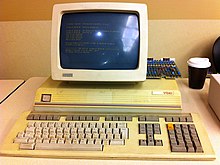 DEC VT220 terminal with LK201 keyboard | |
| Manufacturer | DEC |
|---|---|
| Type | Computer terminal |
| Release date | November 1983 |
| Introductory price | US$1,295 (equivalent to $4,000 in 2023) |
| CPU | Intel 8051 @ 11.0592 MHz |
| Memory | 16 KB RAM 24 KB ROM 256 byte NVRAM |
| Display | 12 in (30 cm) CRT 80x24 characters |
| Input | LK201 keyboard |
| Connectivity | RS-232 serial 20 mA current loop DE-9 serial printer port |
| Predecessor | VT100 |
| Successor | VT320 |


The VT200 series is a family of computer terminals introduced by Digital Equipment Corporation (DEC) in November 1983.[1][2] The VT220 was the basic version, a text-only version with multi-lingual capabilities. The VT240 added monochrome ReGIS vector graphics support to the base model, while the VT241 did the same in color. The 200 series replaced the successful VT100 series, providing more functionality in a much smaller unit with a much smaller and lighter keyboard. Like the VT100, the VT200 series implemented a large subset of ANSI X.364. Among its major upgrades was a number of international character sets, as well as the ability to define new character sets.
The VT200 series was extremely successful in the market. Released at $1,295,[3] but later priced at $795, the VT220 offered features, packaging and price that no other serial terminal could compete with at the time. In 1986, DEC shipped 165,000 units, giving them a 42% market share, double that of the closest competitor, Wyse. Competitors adapted by introducing similar models at lower prices, leading DEC to do the same by releasing the less-expensive $545 VT300 series in 1987. By that time, DEC had shipped over one million VT220s.[4]
- ^ Richard Shuford (1995–2005). "DEC Video Terminals". Archived from the original on 2009-06-05.
- ^ "VT220 Programmer Reference Manual". Digital Equipment Corporation. August 1984.
- ^ Bartimo, Jim (21 November 1983). "DEC Unveils New Design In Successor To VT100". Computerworld. pp. 1, 6. Retrieved 26 January 2023.
- ^ Bright, David (31 August 1987). "DEC VT320 late, but low price surprises". Computerworld. p. 16. Retrieved 26 January 2023.